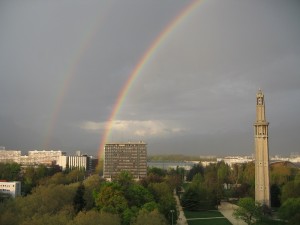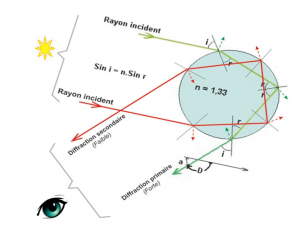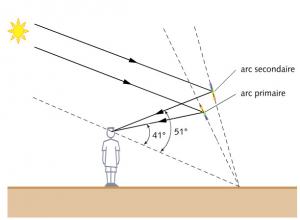Spectacular rainbows
PDFRené Moreau, Professor Emeritus in Grenoble-INP, SIMAP/EPM laboratory, and
Elie Belorizky, former Professor at Joseph Fourier University, Grenoble, LIPhy laboratory

This is due to the refraction of light, an expression that refers to the deviation of light rays as they pass through an interface between two media, such as air and water. It is this refraction phenomenon that explains why a straight stick appears broken when it enters the water. This deflection of light is a function of wavelength, i.e. colour. It is a dispersive phenomenon often highlighted by a prism that splits white light into various wavelengths or colours, and can be seen behind the edge of a window or glass shard.

What is it about? Let us consider a ray of white light that penetrates a spherical drop of water. It is deflected when it undergoes a first refraction through the air/water interface (Figure 2). The ray light then reaches the back surface of the drop, where it is partially reflected. The fraction thus reflected returns to the front face and passes through the water/air interface again, undergoing a second refraction, accompanied by attenuation since part of this ray is reflected towards the inside of the drop. The theory of these two refractions, separated by a reflection, makes it possible to show that the ray reaching the observer’s eye comes from droplets located on the lateral surface of a cone, whose axis is the straight line going from the Sun to the observer’s eye (Figure 3), and whose half-angle at the top varies slightly around 41° according to the wavelength, i.e. according to the colour: 40° for the blue seen inside the cone, 42° for the red seen outside. An important point: these angles are independent of the size of the drop if it is really spherical, which requires that it must be small enough so that the capillary force, or surface tension, should be preponderant over its weight and over friction of the ambient air.

observer and the primary and secondary arcs, based on L’air et l’eau, 2013, EDP Sciences [Source: © EDP sciences]




